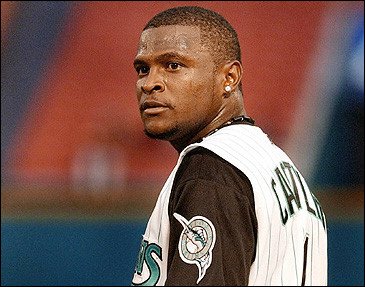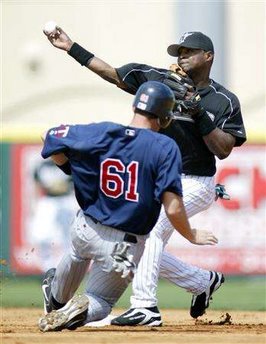December 5, 2005
The New Luis
 I've had the entire weekend to think about the Twins trading for Luis Castillo, so as you can imagine I have quite a few thoughts. First and foremost, this is an excellent trade. That's nothing new for Terry Ryan, of course, but most of his great hauls have come from sending veteran players away for prospects who eventually turn into solid players.
I've had the entire weekend to think about the Twins trading for Luis Castillo, so as you can imagine I have quite a few thoughts. First and foremost, this is an excellent trade. That's nothing new for Terry Ryan, of course, but most of his great hauls have come from sending veteran players away for prospects who eventually turn into solid players.
This time around he's the one parting with two prospects, Travis Bowyer and Scott Tyler, for Castillo. So, the obvious question is what the future holds for the two guys the Twins lost. The centerpiece of the deal from Florida's point of view is undoubtedly Bowyer, whom I like quite a bit. Here is what he's done in the minors over the years:
YEAR LVL IP ERA SO BB H
2002 A 91.2 2.16 90 46 74
2003 A 80.0 3.82 70 56 68
2004 A 29.2 0.30 32 17 18
AA 61.1 1.76 65 38 42
2005 AAA 74.1 2.78 96 40 51
A second-round pick in 2001, Tyler has also struggled with control problems and is even easier to part with. He had a decent year at Single-A, posting a 3.95 ERA in 23 starts, but his 48 walks (3.7/9) and 18 homers allowed in 118.1 innings are concerns. The walk rate actually represents an improvement from previous seasons (5.6/9 in 2004, 6.9/9 in 2003), and the increase in homers suggests that he might have been throwing fat pitches over the plate to improve his control.
Regardless of the explanation, Tyler's numbers for a 22-year-old in the Florida State League are not great. I could certainly see him becoming a solid middle reliever at some point if he makes the switch to the bullpen, but I don't think he ever had much chance of making a major impact as a starter for the Twins.
If everything breaks right for the Marlins in this deal, they will end up with two young, hard-throwing relievers. Even that worst-case scenario for the Twins is something they can live with when Joe Nathan, Juan Rincon, and Jesse Crain are already established in the bullpen, and prospects like Pat Neshek, J.D. Durbin, Boof Bonser, and Beau Kemp are potentially ready for relief roles in the near future.
For the most part, this deal is as if the Twins had simply signed Castillo as a free agent. I consider losing Tyler to be of little significance, and losing Bowyer is like giving up the first-round pick they would have lost as free-agent compensation. Castillo's remaining contract -- $5 million in 2006, with a $5.75 million option for 2007 -- is very palatable and likely even underpriced in this market.

So Castillo came at the right price, but what exactly do the Twins have in him? First and foremost, a middle infielder who can actually get on base. That may not sound like such a big deal, but considering recent Twins history it definitely is. Take a look at the pathetic on-base percentages the Twins have gotten from their middle infielders since the team returned to competitiveness in 2001:
YEAR 2B SS
2001 .324 .324
2002 .302 .299
2003 .288 .321
2004 .308 .310
2005 .320 .283
YEAR OBP
1999 .384
2000 .418
2001 .344
2002 .364
2003 .381
2004 .373
2005 .391
CAREER .370
YEAR OBP
Doug Mientkiewicz 2003 .393
Corey Koskie 2003 .393
Doug Mientkiewicz 2001 .387
Lew Ford 2004 .381
Joe Mauer 2005 .372
Almost all of the ridiculous number of things I've read about Castillo over the past 72 hours has named his defense as a major strength. For instance, here's what ESPN.com's MLB Insider Scouting Report says about him:
Arm Accuracy
Rating: GOOD
Notes: Has carry to his throwsArm Strength
Rating: GOOD
Notes: Strongest in the league for a 2B; quick releaseRange
Rating: GOOD
Notes: Has good infield actions and quickness

Now that I've gushed about Castillo's ability to get on base and let others gush about his ability to play defense, let's talk a little bit about his sizable faults. Castillo has less power than just about anyone in baseball, and in addition to hitting a grand total of 20 homers in 4,347 career at-bats, he hits surprisingly few doubles and triples for someone with very good speed.
Castillo smacked just four homers and legged out a total of 16 doubles and triples in 439 at-bats this year. That works out to an Isolated Power (slugging percentage minus batting average) of .073, which is higher than his .063 career mark. How bad is that? To put it in a context that Twins fans can relate to, Punto's career Isolated Power is .083. In other words, Castillo has less power than Nick Punto.
Actually, his lack of power isn't so simple. A switch-hitter, Castillo is like Jekyll and Hyde depending on which side of the plate he's batting from. This year, for instance, Castillo hit a measly .259/.368/.280 against righties and an amazing .423/.467/.649 against lefties. And yes, you read all of that correctly, from the .268 slugging percentage against righties to the 1.115 OPS against southpaws.
And that isn't just a one-year fluke. Take a look at his career numbers:
AB AVG OBP SLG OPS IsoP
vs RHP 3259 .287 .368 .325 .693 .038
vs LHP 1088 .311 .378 .448 .825 .137
There are two ways to look at this. One is that the Twins faced right-handed pitchers 71% of the time in 2005, so in the majority of his plate appearances Castillo is going to be slapping singles and drawing walks while contributing little else. That's not great and it lessens the value of his on-base percentage a bit, but at the very least he figures to be standing on first base about 37% of the time.
On the other hand, one of the Twins' weaknesses offensively has been a disproportionate number of hitters who struggle mightily against left-handed pitching. Jacque Jones is the most prominent example because of Ron Gardenhire's maddening refusal to platoon him, but Corey Koskie, Joe Mauer, Justin Morneau, and A.J. Pierzynski also produced very little against southpaws despite playing nearly every day.
It would be nice if Castillo could hit for power from both sides of the plate, and if you're going to have an extreme split it is best to do your damage against righties. However, with Mauer and Morneau around as the key pieces of the Twins' offense and Matthew LeCroy unfortunately taking his lefty-mashing skills elsewhere, it isn't the worst thing in the world to be adding hitters who can beat up southpaws.
Castillo's offensive game is built around speed, ground balls, and bunts, and that skill set figures to be helped by playing in the Metrodome. He is consistently among the MLB leaders in singles and was the most extreme ground-ball hitter in all of baseball this year by a wide margin. The turf will make bunting an even more dangerous weapon, but Castillo's ability to beat out infield hits is probably overstated.

A look at his hit chart over at MLB.com shows that while he certainly beats out more bunts and choppers than most, Castillo still gets the bulk of his singles by hitting the ball past the infield. The fake grass will surely help a few more of those grounders find holes in the defense, but the downside is that playing on turf probably won't be a great thing for Castillo's body.
Castillo turned 30 in September and his recent injury history includes leg and hip problems. None of that is good news for a player whose game is based largely on speed, and it is also concerning that his stolen-base numbers have dropped off dramatically in recent years. Of course, at most the Twins have only committed to him for two seasons, which means how he ages into his mid-30s doesn't matter a whole lot.
All Castillo needs to do is stay healthy for 140 games, match the .302/.381/.373 he's hit over the past three years, and play solid defense. If he can do that, the Twins will have improved a massive amount at the position that has been their biggest weakness for years. His arrival is not going to turn the lineup into one of the best in the league, but it is a nice first step back to offensive respectability that carries little risk.
Today at The Hardball Times:
- MLBAM: The Stealthy Money Machine (by Maury Brown)
Pick of the Day (147-126, +$2,025):
Seattle -4 (-110) over Philadelphia

